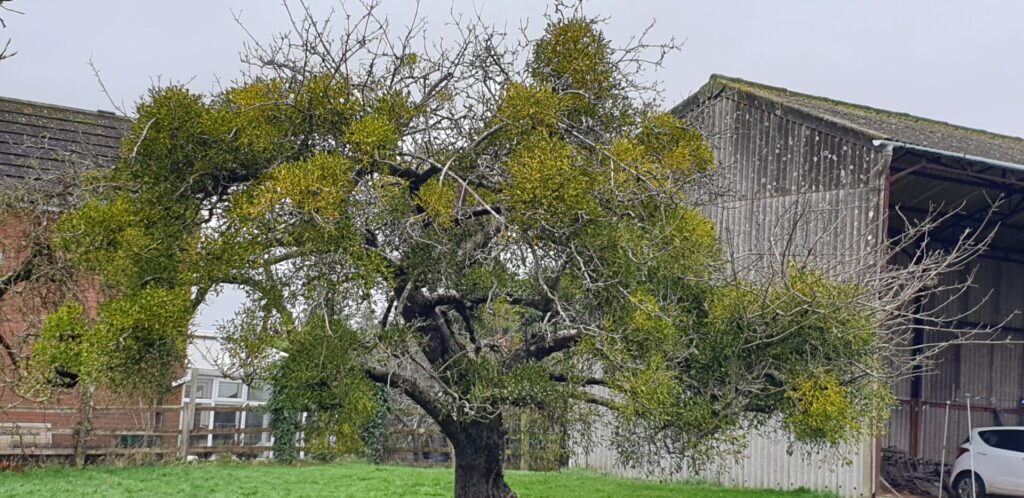
A dear friend suggested writing about this obscure plant: the Mistletoe, after seeing an appletree absolutely loaded with it!
He sent me a picture and then sent some more after he asked the householder to take a few close-ups and then he got kindly invited into his garden.
There were three apple trees in the garden: two covered in both male and female plants of mistletoe. Neither appeared to be suffering in any way and according to the householder, both are producing fruit. The third tree however, which he said has never had any mistletoe growing on it, had recently died!!
That is a bit of a mystery as surely it should have been the other way round?
The mistletoe is semi-parasitic (or hemi?) but also has some other interesting facts which you can read on the next page.
The mistletoe belongs to the Santalaceae or Bastard-toadflax family and the only one other member growing in the B.I.: Thesium humifusum or Bastard-toadflax will also be discussed!
Information and links from various websites and the Medicinal Flora of Britain and Northwestern Europe by J. Barker. The information on habitat and the Scientific Name link is from the Plant Atlas 2020 online. An interesting information sheet about the biodiversity of mistletoe in the U.K. was also used with thanks. See for the entire article: www.mistletoe.org.uk.
Pictures with thanks from Mike Poulton, Ian Trueman as well as from Wikipedia Commons.
Contents
Santalaceae or Bastard-toadflax family
Thesium humifusum or Bastard-toadflax
Viscum album or Mistletoe
Biodiversity value of Mistletoe
So which birds do take mistletoe berries?
Mistletoe abundancy in B.I.
Culture, folklore and mythology
Santalaceae or Bastard-toadflax family
Santalaceae, the sandalwood family (order Santalales), which includes about 44 genera and more than 1,000 species of semi-parasitic shrubs, herbs, and trees, distributed in tropical and temperate regions. The majority of the Santalaceae are root parasites; the others are stem parasites.
In the British Isles there are only two genera and each with one species only.
The Mistletoe used to be in the Loranthaceae, when I was a student, but is now in the Santalaceae, a mostly Tropical plantfamily, together with the one other genus of a totally different appearance!
Loranthaceae, commonly known as the ‘showy mistletoes’, is still a family of flowering plants. It consists of about 75 genera and 1,000 species of woody plants, many of them semi-parasites. Originally, Loranthaceae contained all mistletoe species, but the mistletoes of Europe and North America (Viscum, Arceuthobium, and Phoradendron) belong now to the family Santalaceae.
The Santalaceae in the B.I. has only 2 genera/species which are very different in appearance:
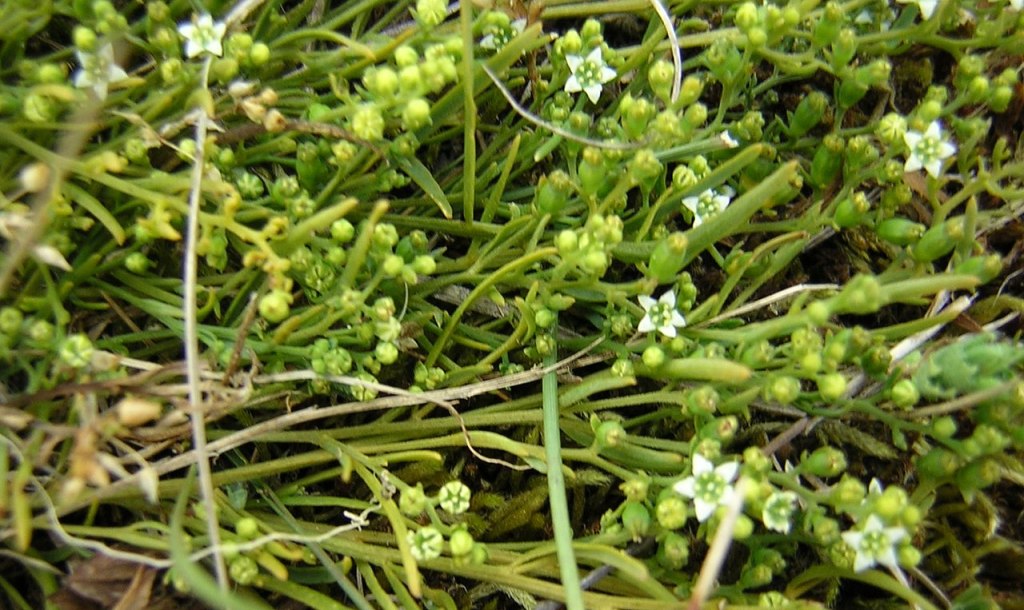
Thesium humifusum or Bastard-toadflax
A perennial herb, with prostrate herbaceous shoots from a woody rootstock, which is hemi-parasitic on the roots of various herbs. It is found in short, usually heavily grazed, species-rich calcareous grassland, chiefly on chalk, less frequently on limestone, and rarely on clays or calcareous sandy soils near the coast. Little is known of its reproductive biology.
The common name comes from the fact that this plant has leaves very similar to many plants in the Linaria (Toadflax) genus although the flowers are completely different.
Thesium humifusum steals nutrients from hedge bedstraw (Galium album) or lady’s bedstraw (Galium verum) in the Rubiaceae, covered in a former post. Although it can be abundant in appropriate habitats, its low growth habit and inconspicuous flowers mean that it is often overlooked.
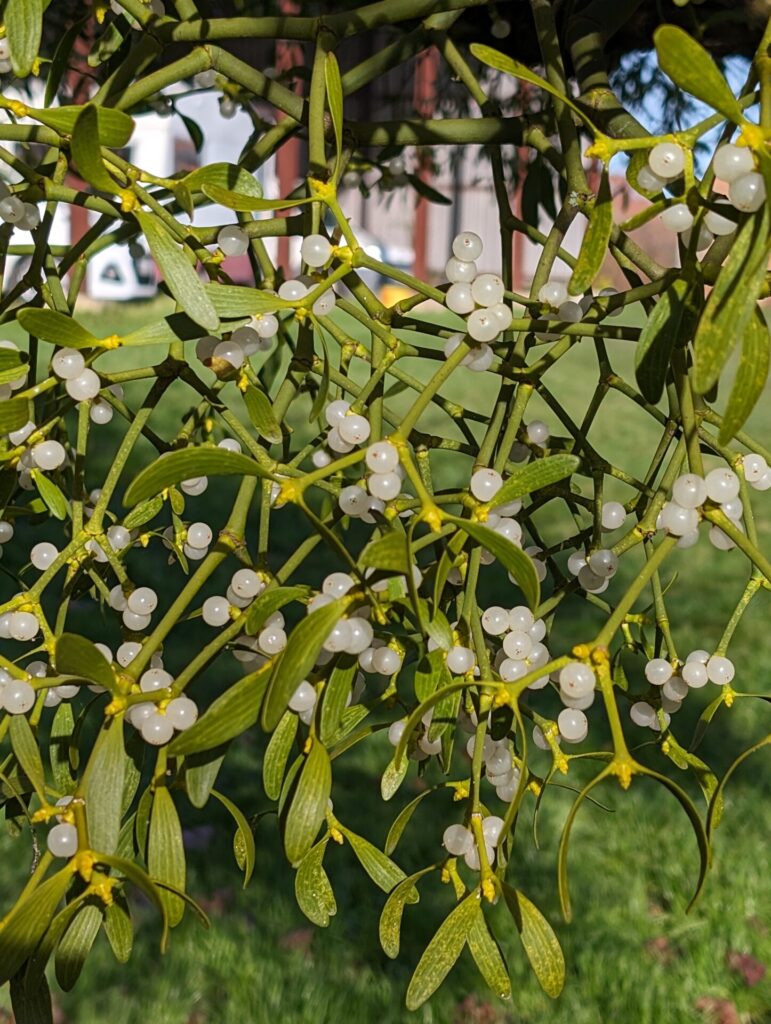
Viscum album or Mistletoe
A hemi-parasite on a wide range of trees in orchards, hedgerows, parklands and gardens, but rarely in dense or primary woodlands. Its most frequent hosts are Malus species, followed by Tilia × europaea, Crataegus species (its most common native hosts), Populus species, Acer species, Salix species and Robinia pseudoacacia. Generally lowland, but reaching 430 m on Black Hill (Shropshire).
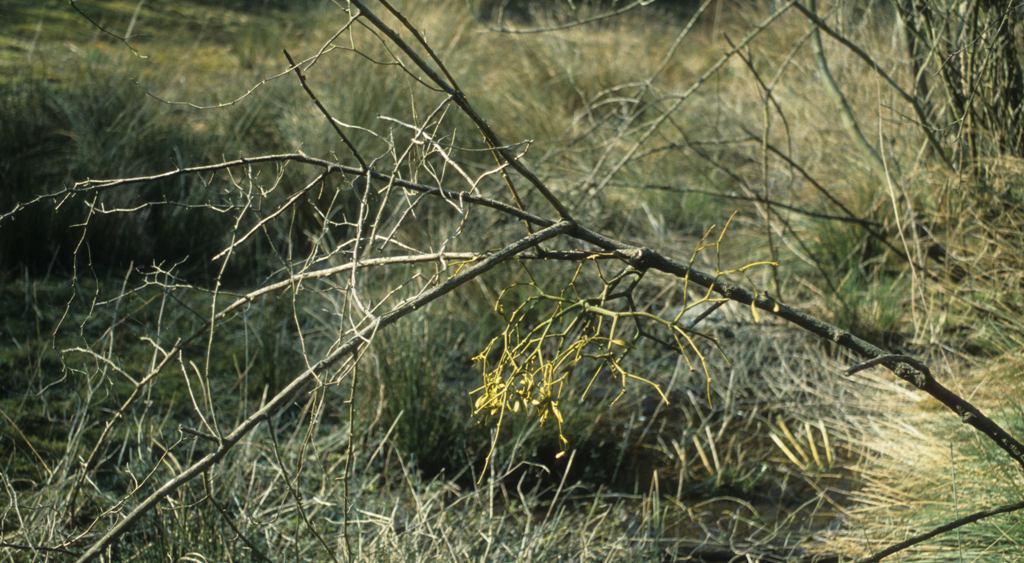
From the Flora of Birmingham and the Black Country: ‘Atmospheric pollution possibly contributes towards the scarcity of this species in Birmingham and the Black Country with records for isolated individuals found in scattered locations on a number of different host species.‘
The plant contains a haustorium that connects it to the host tree by connecting the xylem and phloem of the mistletoe to that of the host tree, which allows it to receive nutrients and water. As it is evergreen it can also still photosynthesise and make food this way.
Biodiversity value of Mistletoe
Mistletoes all over the world have very interesting inter-actions with other species, and not just with their hosts. Most also form miniature ecosystems of their own, with specialist birds, insects and fungi.
There are two key background issues for European mistletoe with regard to birds. Firstly it relies entirely on winter birds for berry, and therefore seed, distribution – so birds are essential. Secondly the white sticky berries of Viscum album are not attractive to many birds – many ignore them as they are looking for red, orange, black or blue berries (mistletoe is the only true native species with white berries) and even if they
try them the birds are put off by the super-glue quality of the berry pulp.
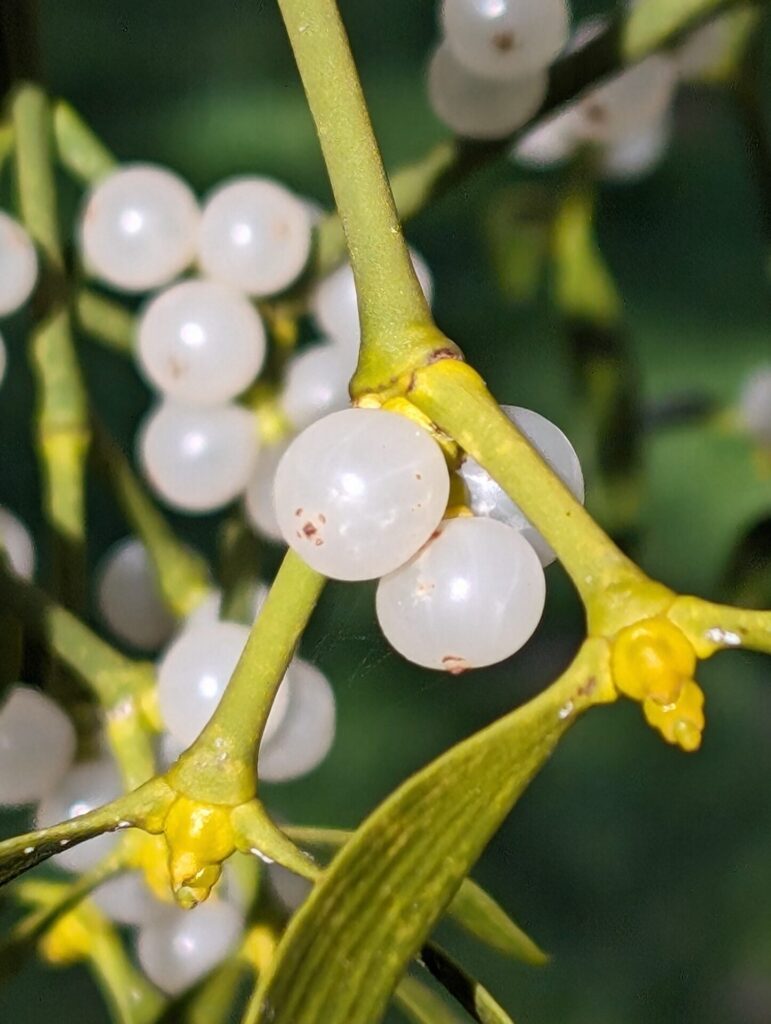
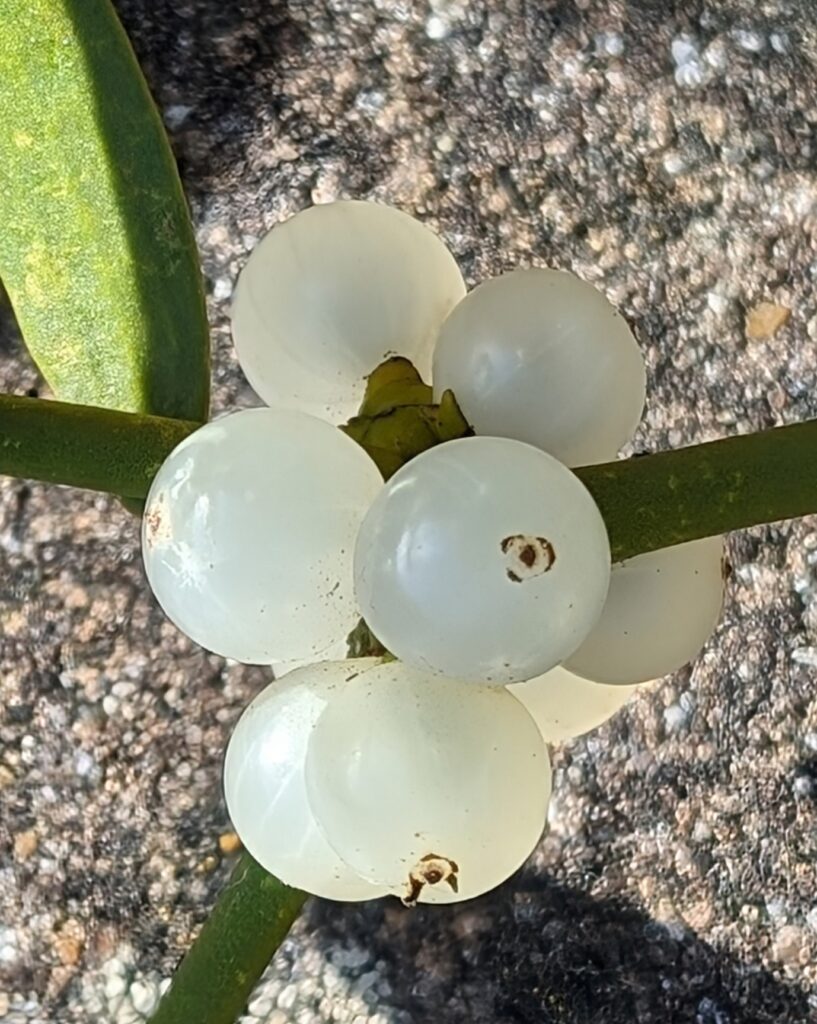
‘Mistletoe is the only true native species with white berries.’ (Pictures by M. Poulton)
So which birds do take mistletoe berries?
In Britain the answer is largely Mistle Thrushes , whose common name and latin name, Turdus viscivorus, hint at a mistletoe specialism. Other thrushes – including Redwings, Fieldfares etc will also eat the berries. They usually swallow the whole berry, seed and all, excreting a mass of semi-digested berry pulp and seeds about 30 minutes later.
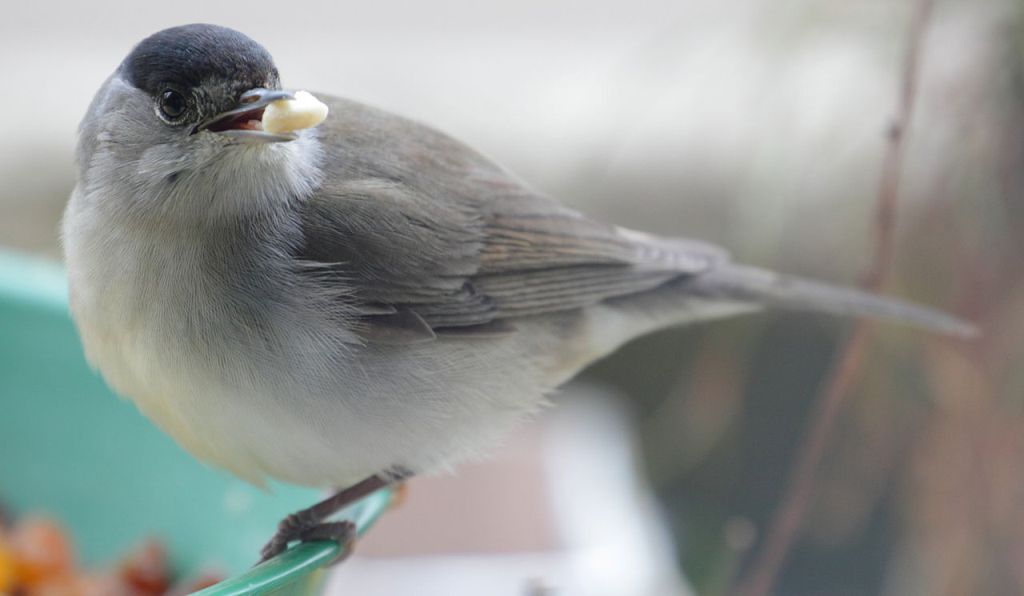
A few other birds will eat mistletoe too, including Waxwings and a few other relatively uncommon species, but the most efficient mistletoe spreading species is the Blackcap!
These smart little birds only swallow the berry skin and pulp, wiping each seed off their beak before swallowing – and so they are much more efficient than Mistle Thushes.
Also see post by Woodland Trust about the Blackcap.
Mistletoe abundancy in B.I. :
Generally, the species would appear to be increasing in abundance locally in much of its range and is certainly now more frequent in the east than previously. See here.
This post also coincides with an article about Mistletoe in the BSBI News of January 2024 called MistleGo, which is a new Mistletoe study across Britain and Ireland. A short paragraph from this article:
In recent years there has been evidence, some anecdotal, some in local measured studies (some reviewed in Briggs, 2021) of both increasing abundance and wider distribution.
This includes the many very neglected old orchards in parts of the Mistletoe stronghold areas. Ironically, rather than the orchard loss leading to Mistletoe decline it now seems that unmanaged excess Mistletoe may be accelerating orchard decline. But the changes are
not limited to that south-west Midlands – they seem to be a national phenomenon, at least in central and southern areas, perhaps less so in the extreme west and north. Similar trends in Mistletoe spread and abundance have also been noted in mainland Europe (Briggs, 2021; Thomas et al, 2023). There is a need for a new study, ideally measuring quantity as well as simple distribution in order to assess current trends and likely management needs.
Until recently there has been little need to manage most Mistletoe populations, but if there is ‘explosive’ (a word used in several studies) growth in numbers there may need to be more management in future.
Culture, folklore and mythology
Mistletoe is potentially fatal, in a concentrated form, and people can become seriously ill from eating the berries.
It features in many myths and legends from early written sources, into the modern period. In cultures across pre-Christian Europe, mistletoe was often seen as a representation of divine male essence (and thus romance, fertility and vitality).
The earliest documented case of kissing under the mistletoe dates from 16th century England, a custom that was apparently very popular at that time.
Mistletoe is commonly used as a Christmas decoration, though such use was rarely alluded to until the 18th century. According to custom, the mistletoe must not touch the ground between its cutting and its removal as the last of Christmas greens at Candlemas. It may remain hanging throughout the year, often to preserve the house from lightning or fire, until it is replaced the following Christmas Eve.
Every year, the UK town of Tenbury Wells holds a mistletoe festival and crowns a ‘Mistletoe Queen’.
Mistletoe is the county flower of Herefordshire. It was voted such in 2002 following a poll by the wild plant conservation charity Plantlife.
Mistletoe is an ingredient of biska, a pomace brandy-based liquor made in Istria.
Mistletoe leaves and young twigs are used by herbalists, and preparations made from them are popular in Europe, especially in Germany, for attempting to treat circulatory and respiratory system problems. Use of mistletoe extract in the treatment of cancer originated with Rudolf Steiner, the founder of Anthroposophy.
Extract from the Medicinal Flora:
Uses are essential for hypertension, nervous tachycardia and nervous crises. also arteriosclerosis and chorea. it has been used in the past for epilepsy. The plant is probably active by topical application to a tumour.
